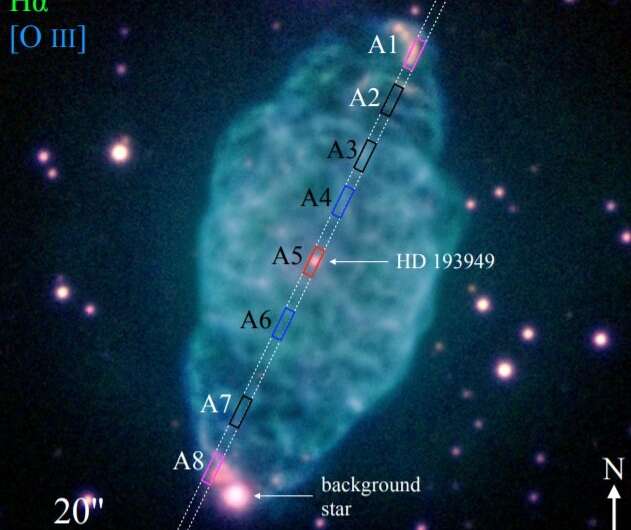Research inspects planetary nebula NGC 6905 and its central star

Using the Nordic Optical Telescope (NOT), astronomers have investigated a planetary nebula known as NGC 6905 and its central star. Results of the study, presented in a paper published October 18 on the arXiv pre-print server, provide more insights into the nature of this object.
Planetary nebulae (PNe) are expanding shells of gas and dust that have been ejected from a star during the process of its evolution from a main sequence star into a red giant or white dwarf. They are relatively rare, but are important for astronomers studying the chemical evolution of stars and galaxies.
At a distance of about 8,800 light years away from the Earth, NGC 6905, also known as the "Blue Flash Nebula" for its characteristic colors, is a high-excitation PN with a clearly clumpy morphology. It is composed of a central roundish cavity with an angular radius of some 0.81 light years and a pair of extended V-shaped structures extending towards two opposite directions. The central star of this PN, designated HD 193949, is a Wolf-Rayet-type star with a radius of about 0.15 solar radii, mass of approximately 0.6 solar masses, and effective temperature in the range of 150,000–165,000 degrees K.
A team of astronomers led by Víctor Mauricio Alfonso Gómez-González of the National Autonomous University of Mexico has recently conducted a multi-wavelength study of NGC 6905 and HD 193949, aiming to shed more light on the properties and structure of this object. The research is based mainly on the data from NOT's Alhambra Faint Object Spectrograph and Camera (ALFOSC), but also on archival infrared images obtained from telescopes such as NASA's Spitzer and WISE.
"We present a multi-wavelength characterisation of the planetary nebula (PN) NGC 6905 and its [Wolf-Rayet]-type ([WR]) central star (CSPN) HD 193949. Our Nordic Optical Telescope (NOT) Alhambra Faint Object Spectrograph and Camera (ALFOSC) spectra and images unveil in unprecedented detail the high-ionization structure of NGC 6905," the researchers wrote in the paper.
The observations allowed the team to detect the three broad WR bumps, the so-called O-bump, blue bump and red bump, confirming that HD 193949 belongs to the [WO]-class of Wolf-Rayet stars. They also detected 21 WR features which suggest that the spectral type of this CSPN cannot be later than a [WO2]-subtype star. The effective temperature of HD 193949 was measured to be around 140,000 degrees K, therefore lower than previously thought.
Based on the data, the astronomers investigated the physical properties and chemical abundances of different regions of NGC 6905. They found that the low-ionization knots located at the northwest and southeast regions of this PN do not exhibit different electron density nor electron temperature compared to its other regions. The averaged value of electron density was calculated to be 500/cm3, while the electron temperature was estimated to be at a level of 13,000 degrees K.
The researchers noted that NGC 6905 has similar abundances as other WRPN, but a slightly smaller nitrogen to oxygen ratio.
"In particular, comparing the N/O ratio versus the N abundance following previous studies suggests that the CSPN of NGC 6905 had a relatively low initial mass of about 1 solar mass. This makes NGC 6905 one of the WRPN with the less massive central star," the scientists explained.
The study also allowed the astronomers to conclude that there is no anomalous carbon-enrichment within NGC 6905 which suggests that no very late thermal pulse (VLTP) has been involved in its formation of or the production of its central star. Additionally, the team reproduced the nebular and dust properties of NGC 6905 and found that the total mass of gas in this PN is in the range of 0.31 and 0.47 solar masses, while the mass of dust was estimated to be between 0.00224 and 0.00169 solar masses.
© 2021 Science X Network
No comments:
Post a Comment